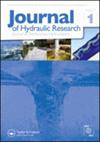非对称重力流与LES碰撞的研究
IF 1.7
3区 工程技术
Q3 ENGINEERING, CIVIL
引用次数: 0
摘要
摘要本文研究了两种不同密度和/或高度的重力流在半深度锁交换装置中碰撞的LES结果。首次研究了不同密度和高度重力流碰撞的动力学特征、碰撞后运动和混合。结果表明,排液的最大高度取决于重力流的高度差,而不受重力流密度差的影响。碰撞时的最大垂直速度取决于高度和密度差,并随着不对称的增加而减小。碰撞后阶段由两个反向的孔组成,它们的速度和高度随时间几乎是恒定的。当相互碰撞的重力流密度或高度相差很大时,碰撞后只产生一个孔。钻孔速度与重力流不同高度碰撞的水力理论吻合较好。混合在碰撞过程中得到增强,消耗了大约20%的系统总消耗能量。关键词:碰撞重力流;大涡模拟;锁交换混合确认本工作的模拟已使用塞萨洛尼基亚里士多德大学(AUTh)高性能计算基础设施和资源进行。披露声明作者未报告潜在的利益冲突。本项目是第一作者博士论文的一部分。博士论文的实施由希腊和欧洲联盟(欧洲社会基金- esf)共同资助,通过“人力资源开发、教育和终身学习”业务方案,在“通过开展博士研究提高人力资源研究潜力”法案的背景下,分行动2:希腊大学博士候选人IKY奖学金计划;国家奖学金基金会。本文章由计算机程序翻译,如有差异,请以英文原文为准。
Investigation of asymmetric gravity current collision with LES
AbstractThis study presents LES results of two colliding gravity currents, with different densities and/or heights, in a half-depth lock-exchange set-up. The dynamical features of collision for gravity currents with different densities and heights, the post-collision motion and the mixing are examined for the first time. It is found that the maximum height of the displaced fluid depends on the gravity currents heights difference, while it is not affected by their density difference. Maximum vertical velocity during collision depends on both height and density difference and decreases with increasing asymmetry. Post-collision phase consists of two counterflowing bores with almost constant velocities and heights with time. When the collided gravity currents have considerably different densities or heights only one bore emerges after collision. Bore velocities agree relatively well with the hydraulic theory of gravity currents collision with different heights. Mixing is enhanced during collision consuming approximately 20% of the total consumed system energy.Keywords: Collisiongravity currentslarge-eddy simulationlock-exchangemixing AcknowledgementsThe simulations for this work have been performed using the Aristotle University of Thessaloniki (AUTh) High Performance Computing Infrastructure and Resources.Disclosure statementNo potential conflict of interest was reported by the author(s).Additional informationFundingThis project is part of the first author’s doctoral thesis. The implementation of the doctoral thesis is co-financed by Greece and the European Union (European Social Fund-ESF) through the Operational Programme «Human Resources Development, Education and Lifelong Learning» in the context of the Act “Enhancing Human Resources Research Potential by undertaking a Doctoral Research” Sub-action 2: IKY Scholarship Programme for PhD candidates in the Greek Universities; State Scholarships Foundation.
求助全文
通过发布文献求助,成功后即可免费获取论文全文。
去求助
来源期刊

Journal of Hydraulic Research
工程技术-工程:土木
CiteScore
4.90
自引率
4.30%
发文量
55
审稿时长
6.6 months
期刊介绍:
The Journal of Hydraulic Research (JHR) is the flagship journal of the International Association for Hydro-Environment Engineering and Research (IAHR). It publishes research papers in theoretical, experimental and computational hydraulics and fluid mechanics, particularly relating to rivers, lakes, estuaries, coasts, constructed waterways, and some internal flows such as pipe flows. To reflect current tendencies in water research, outcomes of interdisciplinary hydro-environment studies with a strong fluid mechanical component are especially invited. Although the preference is given to the fundamental issues, the papers focusing on important unconventional or emerging applications of broad interest are also welcome.
 求助内容:
求助内容: 应助结果提醒方式:
应助结果提醒方式:


